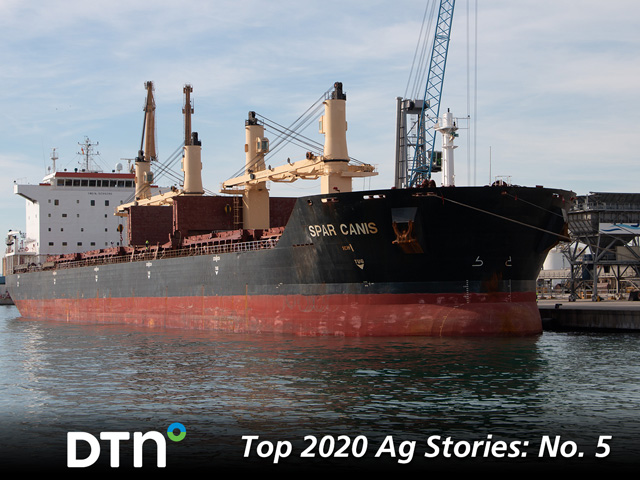Top 10 Ag Stories of 2020 - 5
Trade Alliances Tested, Redrawn in 2020
MT. JULIET, Tenn. (DTN) -- Each year, DTN publishes our choices for the top 10 ag news stories of the year, as selected by DTN analysts, editors and reporters. Today, we continue the countdown with No. 5, looking at high-staked international trade deals taking effect during the year.
**
2020 started with a big deal, but even bigger doubts.
China had committed to purchasing $36.5 billion of U.S. agricultural products as part of the phase-one trade deal. Even before coronavirus hit global markets, there were concerns that there wasn't enough on China's shopping list or in American larders to meet the lofty target.
Then, doubts grew as the wording of the agreement revealed a "commercial considerations" loophole that would let China walk away as the virus ravaged the global economy. Come midsummer, Chinese officials reaffirmed their intentions of fulfilling their side of the agreement and by fall the country turned to international markets to feed its rebounding hog herd amid a feedstock shortage. Grain and oilseed prices began to rise, as did the value of China's purchases.
"Given the sales on the books, I expect the year-end total could reach $26 billion," DTN Lead Analyst Todd Hultman said. While he gives China's unexpected feed supply situation most of the credit for the recent price rallies, "the phase-one agreement happened to be in effect at the time and gets some credit," he said. "It is evident to me looking at current crop prices that $26 billion has been a big bullish shot in the arm for U.S. farmers."
While the export demand has given the U.S. agricultural economy a jolt, the trade landscape for 2020 was far more nuanced. Several important deals were signed or went into effect, while a number more were left incomplete, dangling unknowns into 2021.
One of the most important deals doesn't involve the U.S. at all. In November, China and 14 other countries agreed to a multi-lateral free trade agreement that encompasses one third of the world's total economic activity. One economist cited by the Associated Press called it a coup for China, allowing Beijing to cast itself as a "champion on globalization and multilateral cooperation" and giving it greater influence over regional trade rules.
P[L1] D[0x0] M[300x250] OOP[F] ADUNIT[] T[]
Just last week, Dow Jones newswires reported China is considering joining the Comprehensive and Progressive Agreement for Trans-Pacific Partnership, the deal that resulted after the U.S. withdrew from the pact.
Then, there's the renegotiated United States-Mexico-Canada Agreement, or USMCA, which went into effect on July 1. "I saw no obvious change in market prices due to USMCA, but I think it's fair to say, had that agreement not been reached, we would have seen lower prices," Hultman said.
The agreement was forecast to boost U.S. ag exports by about $2 billion per year with 12% of that coming from higher dairy sales to Canada. But soon after the deal went into effect, dairy processors raised concerns about Canada meeting its obligations of opening its tariff rate quotas and eliminating two classes of milk Canada created specifically to protect its markets.
In early December, the U.S. Trade Representative filed the first "consultation request" under the agreement's compliance enforcement provisions. It argues Canada's tariff-rate quotas set aside a percentage of quotas for processors as well as so-called "further processors," a move that limits U.S. producers and exporters' access to in-quota quantities guaranteed under USMCA.
And then there's Europe. While the United Kingdom officially left the European Union at the end of January, it has until the end of the year to negotiate a new trading arrangement with the EU or face a costly system of tariffs and quotas. As of this writing, those talks look contentious, with U.K. Prime Minister Boris Johnson saying a no-deal scenario is very likely.
The U.K. is also negotiating other trade agreements to replace what it's giving up by leaving the EU trading bloc. It signed an agreement with Canada in November to continue trading under the terms of the EU treaty while they work toward a bilateral deal.
According to the Associated Press, the U.K. has secured post-Brexit agreements with 53 countries, but the U.S. is not one of them. Perennial agricultural issues, like hormone-free beef and poultry washed with microbial chlorine, are at the heart of the remaining issues, although U.S. Trade Ambassador Robert Lighthizer has said he is hopeful a last-minute deal can be struck.
Trade pacts played an important part in the narrative of 2020, but whether that's a net positive for U.S. agriculture will be determined in 2021 and years to come.
**
Editor's Note: You can find No. 5 in DTN's top 10 list on Dec. 25.
See Best of the Rest here: https://www.dtnpf.com/…
See No. 10 here: https://www.dtnpf.com/…
See No. 9 here: https://www.dtnpf.com/…
See No. 8 here: https://www.dtnpf.com/…
See No. 7 here: https://www.dtnpf.com/…
See No. 6 here: https://www.dtnpf.com/…
Katie Dehlinger can be reached at katie.dehlinger@dtn.com
Follow her on Twitter at @KatieD_DTN
(c) Copyright 2020 DTN, LLC. All rights reserved.




